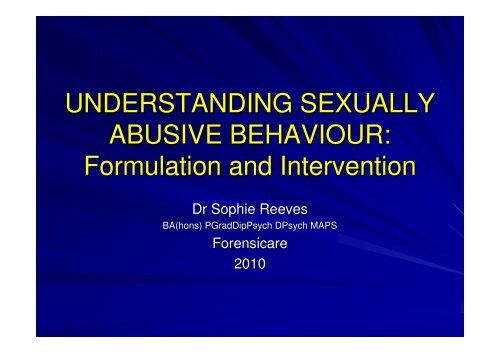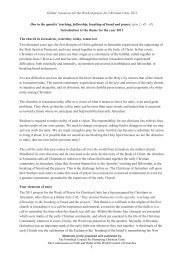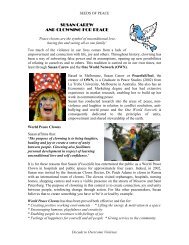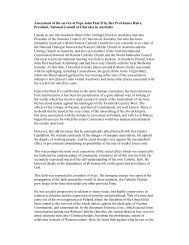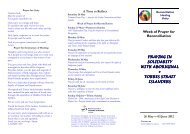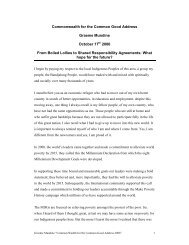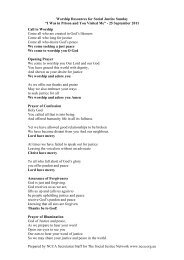Dr Sophie Reeves, Clinical Psychologist, Victorian Institute of ...
Dr Sophie Reeves, Clinical Psychologist, Victorian Institute of ...
Dr Sophie Reeves, Clinical Psychologist, Victorian Institute of ...
Create successful ePaper yourself
Turn your PDF publications into a flip-book with our unique Google optimized e-Paper software.
UNDERSTANDING SEXUALLY<br />
ABUSIVE BEHAVIOUR:<br />
Formulation and Intervention<br />
<strong>Dr</strong> <strong>Sophie</strong> <strong>Reeves</strong><br />
BA(hons) PGradDipPsych DPsych MAPS<br />
Forensicare<br />
2010
Overview<br />
Assessment<br />
- Defining sexually abusive behaviour<br />
- Formulating sexual problems<br />
- Victim impact: the ripple effect<br />
- Assessment <strong>of</strong> risk <strong>of</strong> sexual recidivism<br />
Intervention<br />
-Pharmacological treatment<br />
-Psychological treatment<br />
-Environmental management
Types <strong>of</strong> Sexually Abusive<br />
Sexual Harassment<br />
Behaviour<br />
Any form <strong>of</strong> unwelcome attention that is <strong>of</strong>fensive, humiliating or o<br />
intimidating<br />
making promises or threats in return for sexual favours;<br />
uninvited kisses, embraces, touching or other physical contact;<br />
repeated invitations to go out after prior refusal;<br />
smutty or sexist jokes or comments, or sexually explicit conversation;<br />
sexual gestures or sex based insults, taunts, teasing or name calling;<br />
staring or leering at a person or parts <strong>of</strong> their body;<br />
displays <strong>of</strong> sexually graphic material including posters, pictures, graffiti or<br />
reading material;<br />
persistent questions or insinuations about a person’s private life;<br />
<strong>of</strong>fensive phone calls, letters, e-mail messages or computer screen saver<br />
messages;<br />
innuendo, including sexually provocative remarks and suggestive or<br />
derogatory<br />
comments about a person's physical appearance.
Indecent exposure<br />
Rape<br />
sexual assault<br />
Child molestation<br />
Viewing and/or procuring child pornography<br />
Obscene Communications<br />
Sexually motivated stalking (predatory)
Understanding Sexually Abusive<br />
Behaviour<br />
In what context does sexually abusive<br />
behaviour develop?<br />
What motivates an individual to engage in<br />
sexually abusive behaviour?
Assessment <strong>of</strong> Sexually Abusive<br />
Behaviour: : Sources <strong>of</strong> Information<br />
<strong>Clinical</strong> interview<br />
Psychometric testing<br />
Collateral information
Understanding the Context<br />
Sexually Abusive Behaviour is<br />
Occurring<br />
Mental illness<br />
Paraphilia<br />
Substance abuse<br />
Personality structure<br />
Medical condition
Formulating Sexually Abusive<br />
Behaviour<br />
Individuals who engage in sexually<br />
abusive behaviour are not an homogenous<br />
group<br />
Co-occurrence occurrence <strong>of</strong> sexually abusive<br />
behaviours is not uncommon<br />
Most individuals who engage in sexually<br />
abusive behaviour are male
Female Sexually Abusive<br />
Perpetrators<br />
Research is limited because female perpetrated<br />
sexual abuse is not commonly reported<br />
Existing research has identified:<br />
-typologies <strong>of</strong> females who sexually abuse<br />
-higher rates <strong>of</strong> psychiatric conditions compared<br />
to non-sexual <strong>of</strong>fending female population<br />
-rates <strong>of</strong> sexual recidivism are lower in females<br />
than males<br />
e.g.1% compared to 13-14% 14% over 5 years<br />
Cortoni & Hanson (2005)
Central Features <strong>of</strong> Current<br />
Theories <strong>of</strong> Sexual Offending<br />
<strong>Dr</strong>aw upon cognitive, behavioural, biological and<br />
social learning approaches<br />
Describe multiple pathways to <strong>of</strong>fending<br />
Identify developmental, vulnerability, state and<br />
contextual factors which interact to result in<br />
sexual <strong>of</strong>fending<br />
Sexual <strong>of</strong>fending fulfils certain needs <strong>of</strong><br />
individuals
Pathways Model (Ward & Siegert 2002)<br />
Assumption that every human action involves emotions<br />
or motives, an interpersonal context, cognitive<br />
interpretation and planning, physiological arousal and<br />
activation<br />
There are a number <strong>of</strong> distinct aetiological pathways that<br />
culminate in sexually abusive behaviour<br />
Four sets <strong>of</strong> mechanisms hypothesised to cause clinical<br />
phenomena in sexual <strong>of</strong>fenders<br />
Emotional dysregulation<br />
Intimacy and social skills deficits<br />
Cognitive distortions<br />
Deviant sexual arousal
Sexual<br />
crime<br />
Sexual<br />
crime<br />
Sexual<br />
crime<br />
Common Clusters<br />
Deviant sexual arousal<br />
Intimacy deficits<br />
Inappropriate emotions<br />
Cognitive distortions<br />
vulnerability<br />
Sexual<br />
crime<br />
Family environment Biological factors<br />
Learning history Cultural issues<br />
Sexual<br />
crime
Considering the Offence Process<br />
Cycle <strong>of</strong> <strong>of</strong>fending behaviour<br />
Originally applied to individuals with<br />
substance abuse problems<br />
This model is based upon the premise that<br />
behaviour does not just ‘suddenly happen’
Offence Cycle<br />
Post<br />
Offence<br />
Trigger<br />
Offence<br />
Grooming<br />
Deviant sexual fantasy<br />
Risky thinking<br />
Targeting<br />
High<br />
risk situations
Examples <strong>of</strong> Cognitive Distortions<br />
“It’s s not really harming the victim or me by looking<br />
at it”<br />
“I I have got nothing better to do”<br />
“This will be the last time”<br />
“I’m m just going to look at adult porn”<br />
“I I am educating the victim”<br />
“The victim may enjoy it”<br />
“If I masturbate I relieve the urge to contact others”<br />
‘I’m m just providing support’<br />
‘I’m m just being friendly’
Grooming Techniques<br />
Physical/verbal coercion<br />
Emotional manipulation<br />
Games<br />
Alcohol and drugs<br />
Spiritual manipulation<br />
Grooming <strong>of</strong> parents
Targeting<br />
Vulnerable victims<br />
e.g. Single mother<br />
Individuals with an Intellectual<br />
Disability<br />
Teenagers<br />
Children
Victim Impact<br />
Physical and emotional trauma<br />
Post traumatic stress<br />
Self harming behaviours<br />
Stress associated with disclosure and the<br />
court process<br />
Ripple effect <strong>of</strong> sexual abuse<br />
Sexualised behaviours (children)
Specific Issues for Victims in the<br />
Church Community<br />
Spiritual trauma<br />
Religious beliefs questioned<br />
Confusion over sexuality<br />
Ostracised by church community
Risk Assessment: Questions to ask<br />
Is this individual likely to repeat sexually<br />
abusive behaviour in the future?<br />
Under what circumstances?<br />
Is their behaviour going to escalate?
Two meta-analyses analyses were conducted<br />
examining research evidence concerning<br />
recidivism risk factors for sexual <strong>of</strong>fenders:<br />
(Hanson, Harris, Scott & Helmus, , 1998)<br />
(Hanson & Morton-Bourgon<br />
Bourgon, , 2004)<br />
Data<br />
95 studies involving 31,000 sexual <strong>of</strong>fenders<br />
USA, Canada, UK, Austria, Sweden, Aus<br />
84 studies mixed <strong>of</strong>fence types<br />
79 studies were predominantly adults<br />
Predominantly Caucasian, all male except one study
Strongest Predictors <strong>of</strong> Sexual<br />
Recidivism<br />
Risk factors that research has found to be<br />
the strongest predictors <strong>of</strong> sexual<br />
recidivism include:<br />
* Deviant sexual interests<br />
* Antisocial orientation/(lifestyle instability,<br />
history <strong>of</strong> rule violation)<br />
Emotional identification with children<br />
Conflicts with intimate partners
Risk factors that had no relationship with<br />
sexual re-<strong>of</strong>fending include:<br />
Sexual abuse victimisation<br />
Internalising disorders (anxiety,<br />
depression)<br />
Low self esteem<br />
Degree <strong>of</strong> force in sexual <strong>of</strong>fences<br />
Lack <strong>of</strong> victim empathy<br />
Denial or minimisation <strong>of</strong> <strong>of</strong>fences
Sex <strong>of</strong>fenders are more likely to re-<strong>of</strong>fend<br />
with a non-sexual <strong>of</strong>fence than a sexual<br />
<strong>of</strong>fence<br />
Base rate for sexual re-<strong>of</strong>fending is<br />
approximately 14-17% 17% over 5 years
Intervention<br />
Pharmacological Intervention<br />
Consideration <strong>of</strong> antiandrogens, SSRI’s<br />
Psychological Intervention<br />
Environmental Management<br />
-preventative<br />
-reducing re-occurrence <strong>of</strong> behaviour
Psychological Interventions<br />
Treatment targets<br />
Acceptance and responsibility for <strong>of</strong>fending behaviour<br />
Identification and challenging <strong>of</strong> cognitive distortions that<br />
support sexual <strong>of</strong>fending<br />
Cognitive restructuring <strong>of</strong> general antisocial orientations<br />
Development <strong>of</strong> a positive sexual identity
Reducing deviant sexual arousal and developing<br />
non-abusive sexual fantasies<br />
Understanding the consequences <strong>of</strong> <strong>of</strong>fending<br />
behaviour for the self, the victim and their<br />
families<br />
Development <strong>of</strong> healthy coping mechanisms<br />
Development <strong>of</strong> prosocial relationship skills
The development <strong>of</strong> adaptive strategies in<br />
regulating emotions (e.g. distress, anger)<br />
Development <strong>of</strong> Relapse Prevention strategies<br />
Management <strong>of</strong> addictive, compulsive features<br />
contributing to the reinforcement <strong>of</strong> delinquency<br />
Resolution <strong>of</strong> victimization in the history <strong>of</strong> the<br />
adult
Offence Cycle<br />
Post<br />
Offence<br />
Trigger<br />
Offence<br />
Grooming<br />
Deviant sexual fantasy<br />
Risky thinking<br />
Targeting<br />
High<br />
risk situations
Environmental Management<br />
Preventative Measures<br />
Development <strong>of</strong> policies addressing the<br />
following issues:<br />
- How to respond if there are<br />
concerns/suspicions <strong>of</strong> abuse<br />
- A named contact in the church to co-ordinate<br />
ordinate<br />
concerns and take action<br />
-Safe recruitment procedures for both paid<br />
workers and volunteers<br />
-Guidelines for running church activities with<br />
children and young people
Preventative measures cont.<br />
Seeking appropriate background checks<br />
on employees/volunteers in the church<br />
community<br />
(police check, working with children<br />
check, referees)<br />
Ongoing training <strong>of</strong> employees<br />
Adequate supervision/mentoring
Establishing clear boundaries for<br />
employees/volunteers with regard to<br />
their interactions with individuals<br />
within the church community<br />
Education <strong>of</strong> families and young<br />
people regarding safety and how to<br />
say no
Decision Making Regarding Risk<br />
Management Should Consider the Following<br />
Elements:<br />
Level <strong>of</strong> supervision/monitoring within the<br />
church<br />
Balancing privacy/rights <strong>of</strong> the individual with<br />
risk management needs<br />
Support for the individual (within the church<br />
and/or externally)<br />
Documenting a management plan/contract<br />
detailing what the individual can and can’t t do
Consideration <strong>of</strong> external assessment/consultation by<br />
appropriately qualified practitioner with regard to<br />
decision making<br />
Regular review process required<br />
An awareness that for many individuals, management<br />
will be life long even if the individual has undergone<br />
treatment or received prayer ministry<br />
Appropriate support/privacy for the victim and their<br />
family<br />
Support for other members within the church<br />
community, managing anxiety/hysteria/dispelling myths


